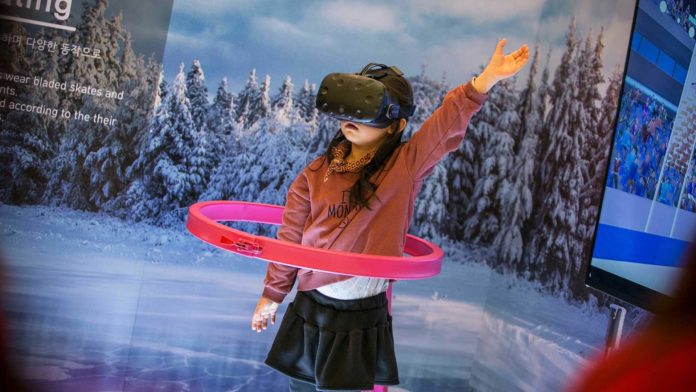The Olympics are kind of like CES in a way, because they act as a debut of new AV technology. Today’s hype is all around utilizing VR and AR, and NBC has pulled out all the stops to provide some incredible technological feats.
Of course, live sports continues to grow in VR but the Olympics provide a unique showcase of athleticism. This year, 4K video and extremely fast network speeds will allow viewers to take in the game as never before, with some unique live experiences and over 50 hours of heart-stopping moments. But live TV isn’t all that VR and AR will bring to the Olympics. In fact, some new technology may change the games (and preparation for them) forever.
Watching the Olympics in VR
The first big piece of VR tech showcasing at the Olympics is the partnership between Intel and NBC to bring 30 events to your Oculus, Samsung Gear VR, Google Daydream or Windows Mixed Reality headset.
That’s not even the coolest part.

Some of these headsets have built-in controller support. You will be able to move around the venue and capture different angles of locations and events. What will you discover?
If you don’t have a headset yet, then you might want to check out the 180 and 360 degree videos on offer from NBC. These are available online, but you will need the NBC Sports VR App for the mobile experience, and in the Oculus Store.
NY Times AR Story
The New York Times is making a big splash with some AR reporting it is doing that looks closer at three US Olympians. Users can download the New York Times App and see the story for themselves, which will occasionally stop and show the Olympian in your room.
The back end utilizes ARKit from Apple, but a version is also available on Android (albeit with slightly less functionality and precision). This way, users will learn more about their favorite Olympians by walking around them and seeing how they perform.
Training Advancements
Haptics are the next big thing in Olympic preparation, as embodied by the Dutch speed skating team. They will be utilizing Samsung’s “Smart Suit”, a series of sensors placed strategically around the body. These sensors gather all kinds of data about an athlete’s form or technique that influence speed at a micro level. Coaches use the Galaxy S8 to relay vibrations to the athlete’s wrist, which act like a code language to tell them how to adjust.
[youtube https://www.youtube.com/watch?v=AhMniFqyREI&w=560&h=315]
Although this technology is only allowed in training runs, athletes can use those vibrations as reminders to correct themselves in a meaningful way. The Olympics are often measured in fractions of seconds, the smallest adjustment might make a difference.
Athletes are also training in VR more and more. We know STRIVR and Stanford have gotten comfortable together as training buddies, and now the US Women’s Ski Team can add their names to the list of athletes who find a competitive edge in VR. In fact, Laurenne Ross found that VR was an effective means to stay in a training mindset even as she recovered from a torn ACL.
5G and AR
At the venue, another important technology that will provide the backbone for wireless VR experiences is getting an important field test. 5G cellular networks are capable of extremely fast transmission speeds exceeding 100 times that of 4G. This incredible network will power a series of automated buses that will cart visitors around the venue, as well as debuting live VR coverage of events.
Users in the stands will be able to rewind and change angles of skaters live. Of course, the same experience will be available to home users as well, but the idea that this can be done live is momentous.
Drone Tech
[youtube https://www.youtube.com/watch?v=fCd6P7Ya160&w=560&h=315]
Drone tech is probably one of the cooler and more underrated highly technical applications in VR. Essentially, Intel has built a system that can manage hundreds of drones based on GPS positioning, battery life and other attributes, to create a lightshow. Hundreds were used in the live version, but the pre-recorded version used thousands for a high definition effect.
Drones are also part of the Olympics security strategy, but information is a bit mum on that front.
What tech has caught your eye from this year’s games?


